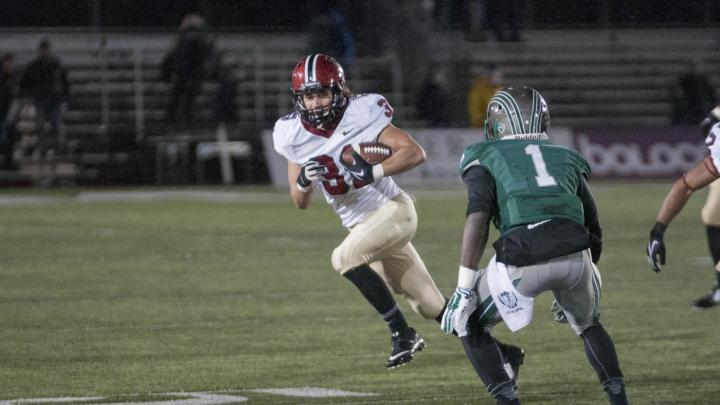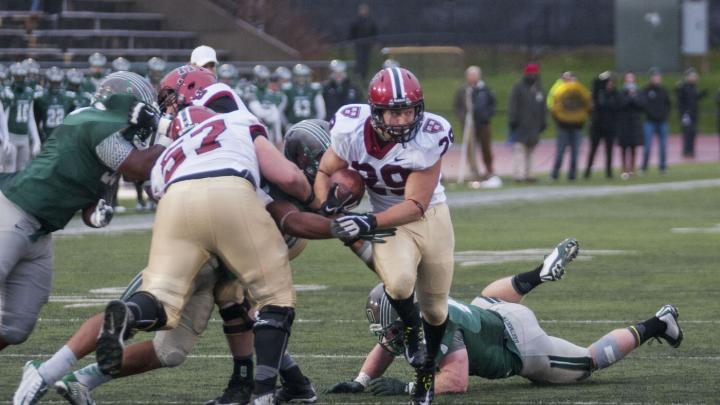Percy Wendell, A.B. 1913, was one of Harvard’s first great running backs. A 5-foot-5, 172-pound fireplug of a fellow, Wendell was nicknamed “The Human Bullet” for a literally straight-ahead running style that put his head (only occasionally helmeted) in harm’s way. Wendell also distinguished himself by being a mudhorse—a player who could keep his feet on the era’s boggy gridirons and in any weather.
Meet the twenty-first-century model. His name is Paul Stanton Jr. The junior from Kenner, Louisiana, is, like Wendell, on the smallish side (5-foot-9, 190 pounds). Stanton also is a back for all seasons. He proved that on Saturday in wet, frigid Hanover, New Hampshire. Cutting and driving for a career-high 180 yards on 24 carries, catching three passes for 55 yards, and scoring two touchdowns, he was the essential element in Harvard’s 23-12 victory over Dartmouth. The win in the showdown between two unbeatens put the Crimson, as the expression goes, firmly in the driver’s seat in the Ivy race. Harvard now stands at 7-0 overall and 4-0 in league play—one game ahead of Dartmouth, Princeton, and Yale. The victory, which followed a 49-7 blowout at Princeton and thus happily closed out a defining two-game road trip, was the Crimson’s tenth in a row spanning two seasons. It also was coach Tim Murphy’s 101st in Ivy play, vaulting him ahead of Bob Blackman. This was poetic justice, given how the Hall of Fame Dartmouth and Cornell coach tormented the Crimson in the 1950s, ’60s, and ’70s.
As has happened so often this season, this was a team triumph. The uncharacteristically opportunistic (three turnovers) defense, led by junior safety Sean Ahern (10 tackles), held a good Big Green offense without a touchdown after the first quarter. It also limited Dartmouth’s star receiver, Ryan McManus, to four catches and 49 yards. And a nifty bit of brotherly sleight of hand produced a touchdown. But when the Crimson needed to control the ball, the strategy was Let Paul Do It. Operating behind Harvard’s overpowering offensive line, the sure-footed Stanton continually pushed the pile and moved the chains. Afterward, Dartmouth coach Buddy Teevens (Murphy’s friend since their days as teammates at Silver Lake High in Kingston, Massachusetts) praised Stanton as “a complete back, a powerful, explosive runner who can also block and catch passes.”
Dartmouth's department of athletics billed the game as “the biggest at Memorial Field in 17 years.” But a Harvard Crimson columnist scoffed, writing, “For Harvard, this is the biggest game since last Saturday.” The Big Green administrators harked back to the 1997 season, when Dartmouth was defending Ivy champion and both teams had league records of 3-0 when they met at Hanover. Harvard blanked the Green, 24-0, and went on to win the first of seven Ivy titles under Murphy. (An omen for 2014?)
The temperature at kickoff was 39 degrees—“That’s probably the coldest I’ve ever played in,” said Stanton—with heavy overcast and light drizzle. Dartmouth's stadium—the league's smallest, seating only 13,000—seemed to hold perhaps 2,000 fans, either New England’s hardiest or foolhardiest. (The announced attendance was close to 6,000, possibly based on ticket sales.) But Harvard’s offense came out hot. It took only 10 plays and 3:38 for the Crimson to go 75 yards. Stanton set an immediate tone, rushing for 17 yards and hooking up with quarterback Conner Hempel ’15 for a 17-yard catch-and-run. Later, from the Dartmouth 22, Hempel passed to tight end Anthony Firkser ’17 for a 19-yard gain on which Firkser toted the ball, and three Dartmouth defenders, to the three. From there, Stanton crashed into the end zone. Andrew Flesher ’15 booted the extra point: 7-0 Harvard. By scoring, the Crimson had quickly taken care of one piece of business, extending to 165 straight games its Ivy record of not being shut out.
After an exchange of punts, Dartmouth and its agile junior quarterback Dalyn Williams answered back. Williams led the Big Green on a 72-yard drive, converting on two third downs and a fourth down. Dartmouth running back Kyle Bramble did most of the heavy work and eventually punched it over from the two. Then came one of the season’s wildest plays. Alex Gakenheimer’s point-after attempt was blocked by 6-foot-5 Crimson defensive tackle Ryan DeLisle ’15. Under a specific rule applying to point-after-touchdown attempts, if Harvard had then taken the ball all the way to the opposite end zone, the Crimson would have been awarded two points. Ahern grabbed the ball and ran downfield. Tackled at around the Dartmouth 15, he fumbled—into the hands of safety Norman Hayes ’15, the Crimson captain, who ran into the Big Green end zone. Alas, on an extra-point conversion, a fumble only can be advanced further by the fumbler. So the score stood Harvard 7, Dartmouth 6.
This was followed by the season’s prettiest play. Early in the second quarter, Harvard brought the ball to the Dartmouth 37. In formation were the Smith brothers from Florida: freshman running back Semar and senior wide receiver Seitu. Hempel handed off to Semar, going left—who handed to Seitu, going right. Seitu stopped and tossed the ball downfield to a wide-open Firkser, who caught it at the 10 and ran on in. Touchdown, Crimson! Even Dartmouth’s deflection of Flesher’s point-after attempt could not spoil the sweetness of this play. Harvard 13, Dartmouth 6.
The middle of the quarter saw two pivotal sequences. Dartmouth worked the ball to the Harvard 28. There, on fourth-and-one, Bramble squirted through a hole but was stopped inches short by two seniors, defensive tackle Obum Obukwelu and linebacker Connor Sheehan. Each had four tackles on the day, and Obukwelu had a sack, but no play was bigger than this one.
When the Harvard offense came back on the field, Hempel was nowhere to be seen. He had been planted on his throwing shoulder by Dartmouth’s mammoth A.J. Zuttah. “I thought I had a broken collarbone,” Hempel said later. Replacing him was battle-tested sub Scott Hosch ’16. Hosch did engineer one first down but then the Crimson was forced to punt. A superb return by McManus was negated by holding. On third-and-five from his 19, Dalyn Williams threw to Victor Williams, who was slammed by linebacker Jake Lindsey ’16 and coughed up the ball. DeLisle recovered.
From there, it took the Crimson only five plays to get the ball in the end zone. Four were rushes by Stanton, including the last, a two-yard score. On the drive, Stanton exhibited one of his outstanding trademarks: patience at the point of attack. “Once you get the ball, let the blocks set up,” is how he describes it. This time Flesher’s kick was good: 20-6 Harvard. With 11 seconds left in the half, Gakenheimer made a 30-yard field goal to cut the score to 20-9.
The second half saw only six points but plenty of action and intrigue. If Hempel could not play, how would this affect Harvard? This question took a back seat to Dartmouth’s opening drive, which produced another Gakenheimer field goal, a 22-yarder that made it 20-12. Suddenly it was a one-score game and it would teeter on that edge till near the finish. Almost like the Western Front in World War I, the sides went back and forth to little avail. With six minutes left in the third quarter, Hempel returned, but he was not sharp. Luckily, at crucial moments, Stanton took over. “I felt like I had to step up for my team,” he said. On third and 15 from the Harvard 42, he blew through for 20 yards. Though that drive petered out, Stanton had provided precious, clock-burning minutes of possession time.
As the fourth quarter began, Dartmouth had its own quarterback trauma. On an incomplete pass, Dalyn Williams, who normally wears a visor but did not have it on because of the rainy conditions, was poked in the eye. He had to be replaced by Alex Park. The Big Green backup (a onetime starter) would complete seven of 11 passes but, because he lacked Williams’ arm strength, they gained only 46 yards.
With 11:02 left, a Dartmouth punt backed Harvard to its 16. Let Paul Do It. On third and three, he smashed for 19 yards. On third-and-one from the Dartmouth 49, he gained three. On the next play, Hempel flipped a 21-yard pass to tight end Tyler Hamblin ’15, who took it to the Dartmouth 25. Three plays later, it was fourth-and-one. The Crimson kicking game has had many shaky moments this year. Do you Let Paul Do It? (If he doesn’t make the yard, Dartmouth still needs to go the full field.)
No. On came Flesher, who in 2013 had scored the winning points against Dartmouth by kicking a 23-yard field goal with 48 seconds left. This year he again came through, this time from 33 yards out. Harvard 23, Dartmouth 12.
The final six minutes saw a Hayes fumble recovery and a nail-in-the-coffin interception by defensive back Jordan Becerra ’16. On the final possession, Stanton just kept churning, with six-yard and 13-yard gains that literally ran out the clock. Averaging 93.8 yards on the ground, he stands second in the Ivies to Yale’s Tyler Varga (136.4), whose record-setting season was the subject of a recent New York Times profile. Afterward, Stanton expressed exhilaration about the way the Crimson pulled this one out on the road. “We love the close ones,” he said. “Blowouts are OK, but games like that are really what we play for.”
There are three games left in the season. It is possible they will be played in wet, in cold, in wind. In other words: Stanton weather.
With special reporting by “Cleat”
Weekend Roundup
Yale 25, Columbia 7
Brown 21, Penn 13
Princeton 38, Cornell 27
Coming up: Next Saturday, Harvard returns home to play Columbia. Kickoff: 1 p.m. (The game will be televised on ESPN3 and the Ivy League Digital Network.) The Lions are 0-7, 0-4 in Ivy play and have lost 18 straight. Harvard leads the series 57-14-1. Since the formation of the Ivy League in 1956, the Crimson is 49-8-1 against the Lions. Harvard has won the last 10, including a 34-0 victory last year in New York City.
On any given Saturday…? Nah. Quite simply, if the Lions win, it will be the biggest upset in Ivy League history.
The football capital of the world is…CAMBRIDGE? On Saturday MIT, which plays football in the NCAA’s Division III as a member of the New England Football Conference, brought its record to 7-0 when the Engineers beat Endicott College 34-29. Hmmm…one town, two teams, 14 wins, no losses. Take that, Tuscaloosa!
Score by quarters
Harvard 7 13 0 3 23
Dartmouth 6 3 3 0 12
Attendance: 5,833











